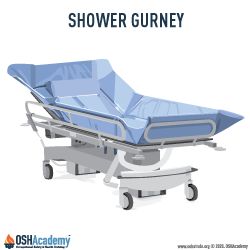Other Ergonomic Hazards
Introduction
Some reports indicate a significant number of work-related MSDs in the healthcare facilities occur in activities other than patient lifting.

Slips, Trips, and Falls
Potential Hazard
Slips/trips and falls from spills or environmental hazards.
Environmental hazards such as:
- slippery or wet floors
- uneven floor surfaces
- lifting in confined spaces
- cluttered or obstructed work areas/passageways
- poorly maintained walkway or broken equipment
- inadequate staffing levels to deal with the workload, leading to single person lifts and greater chances of falls
- inadequate lighting, especially during evening shifts
Possible Solutions
Good work practice includes implementing engineering and work practices controls to help prevent slips/falls such as:
- Eliminate uneven floor surfaces.
- Create non slip surfaces in toilet/shower areas.
- Immediately clean-up of fluids spilled on floor.
- Safely work in cramped working spaces-avoiding awkward positions, using equipment that makes lifts less awkward.
- Eliminate cluttered or obstructed work areas.
- Provide adequate staffing levels to deal with the workload.
Potential Hazard
Increased potential for employee injury exists when awkward postures are used when handling or lifting patients. Awkward postures include:
- forces on the spine increase when lifting, lowering or handling objects with the back bent or twisted
- more muscular force is required when awkward postures are used because muscles cannot perform efficiently
- fixed awkward postures (i.e., holding the arm out straight for several minutes) contribute to muscle and tendon fatigue, and joint soreness
- reaching forward or twisting to support a patient from behind to assist them in walking
Possible Solutions
Good work practice recommends avoiding awkward postures while lifting or moving patients.
- Educate and train employees about safer lifting techniques.
- Use assist devices or other equipment whenever possible.
- Use team lifting based on assessment.
Knowledge Check Choose the best answer for the question.
3-1. What is a good example of an engineering control to help prevent slips and falls?
You forgot to answer the question!
